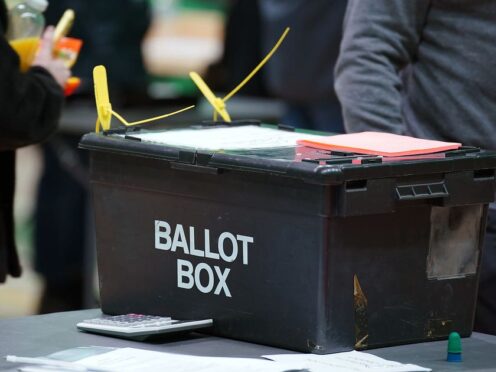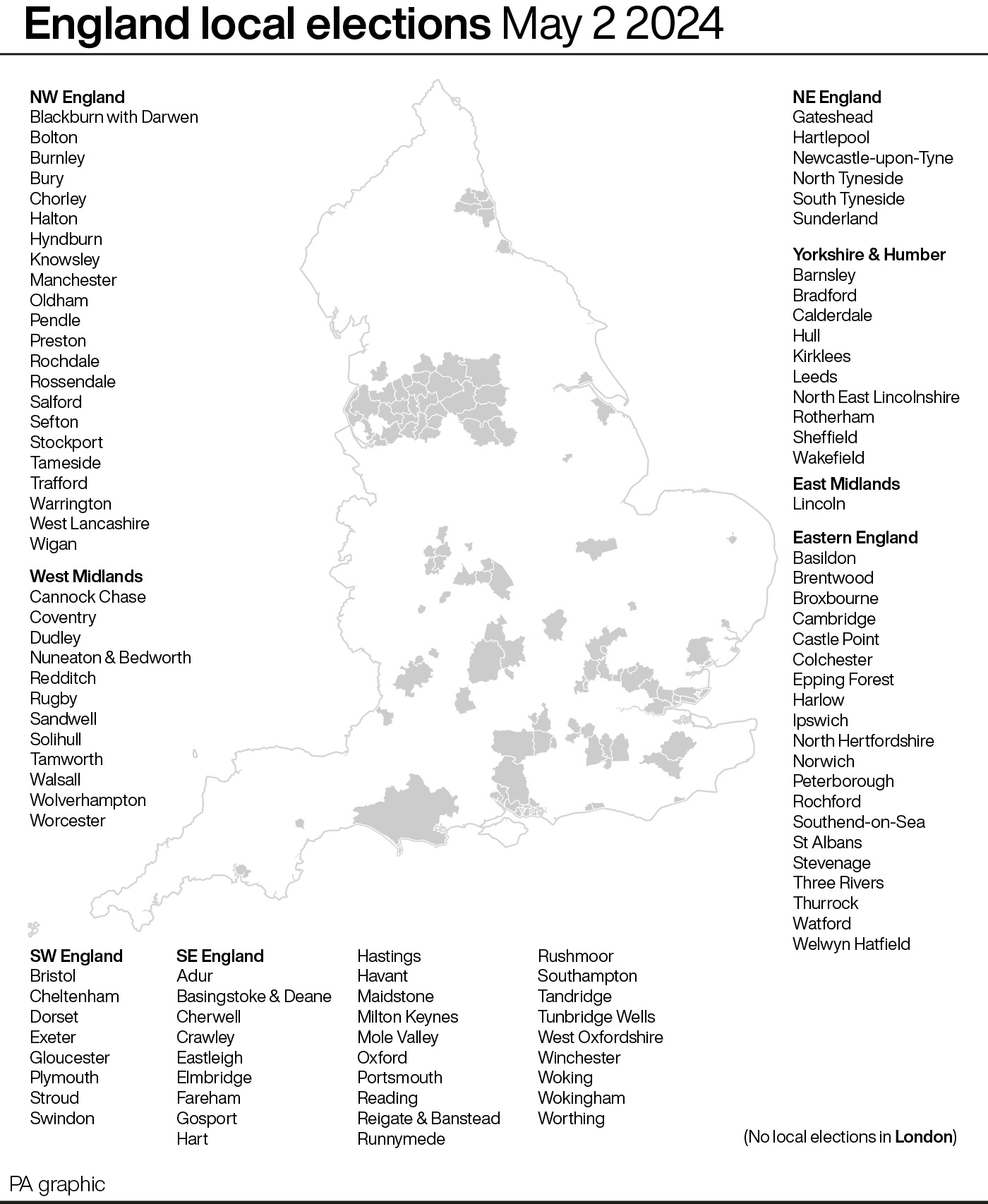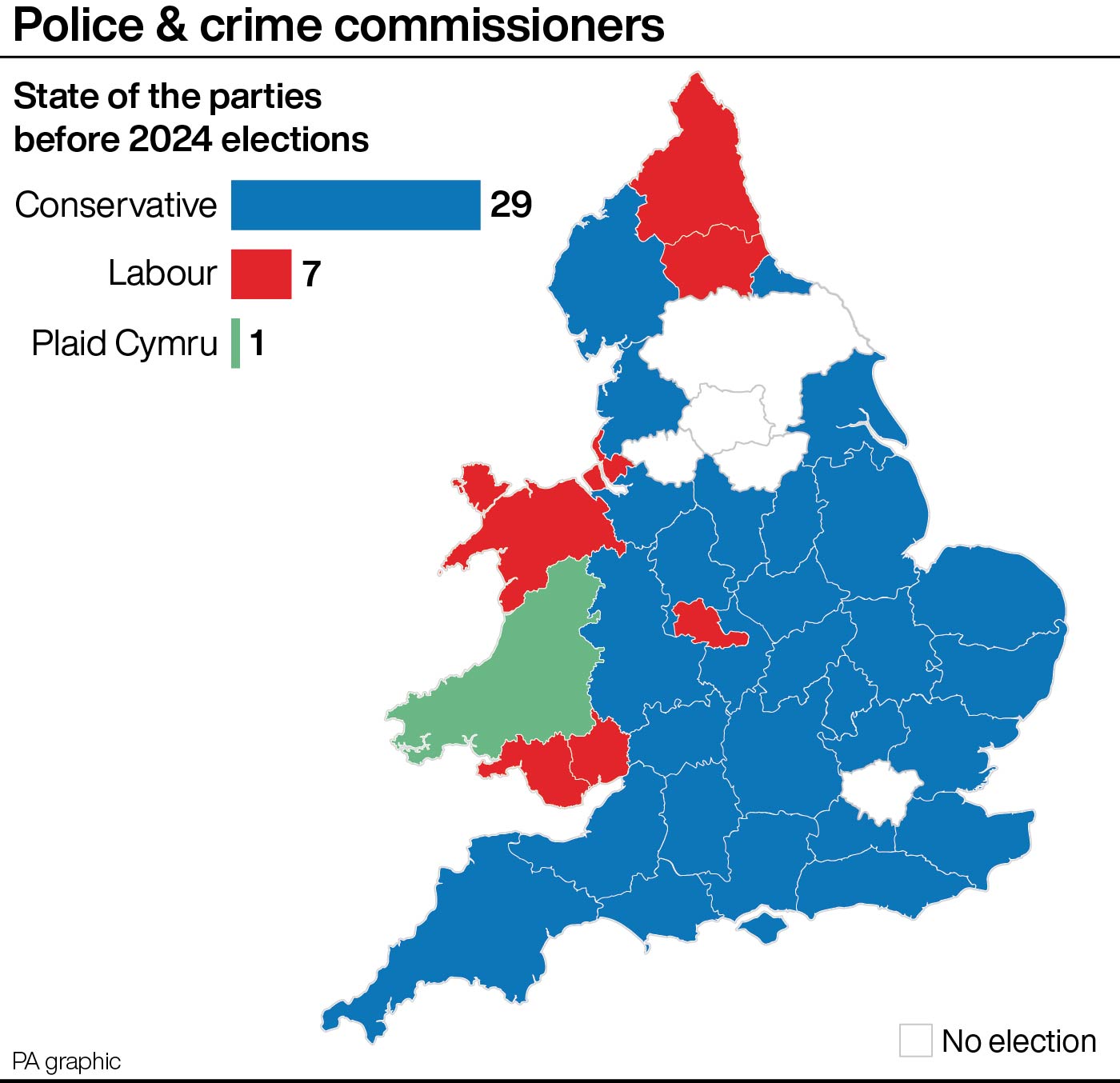
Every voter in England and Wales will be able to cast a ballot in at least one type of election on May 2 – and here are some of the key contests:
– Councils
More than 2,600 council seats in England are up for grabs across 107 authorities, many of which were last fought in 2021, a year in which the Conservatives did particularly well in local elections.
Of the 107 authorities, 31 are Metropolitan boroughs, including some of the UK’s biggest cities such as Leeds, Manchester and Newcastle; 18 are unitary authorities, covering a mix of towns and larger areas; and 58 are smaller district councils.
Most of the Metropolitan boroughs have large Labour majorities and are unlikely to change hands, but a few are worth watching to see how the major parties perform.
Bolton in Greater Manchester has a third of seats up for election and is a key Labour target, with the party needing only a few gains to win an overall majority.
Every seat in Dudley in the West Midlands is up for grabs and Labour could become the largest party if the Conservatives, who currently have a majority, do particularly badly.
In Solihull and Walsall, again in the West Midlands, a third of seats are being elected, but the Tories could lose overall control of these councils if their vote collapses.
Sheffield is likely to remain in no overall control, but could see a three-way tussle between Labour, the Liberal Democrats and the Greens over who ends up the largest party, with a third of seats being contested.

Among the unitary authorities, Dorset in south-west England and Wokingham in Berkshire both have every seat up for grabs and are key “blue wall” battles for the Liberal Democrats.
The party is close to an outright majority in Wokingham and could make enough progress in Dorset to deprive the Conservatives of overall control.
The Greens are already the largest party in Bristol, but up to now Labour has been running the council through its directly-elected mayor.
That position is being abolished, however, giving the Greens a chance to take overall control on May 2, helped by the entire council being up for election.
Hartlepool in County Durham has a third of its seats up for grabs and is another key Labour target, where the party is very close to an overall majority and which is currently run by a coalition of Conservative and Independents.
Southend-on Sea and Thurrock in Essex both have a third of seats being elected and both are currently run by Conservative minority administrations, but are worth watching to see if Labour manages to make progress in what will be crucial battleground areas at the general election.
In the last of the three categories of council, the districts, Hyndburn in Lancashire will offer a good measure of Labour’s performance, where a third of seats are in play and the party needs only two gains for a majority.
Every seat in Cannock Chase in Staffordshire is up for election, where the Tories and Labour are currently tied and where both hope to emerge the largest party.
Basildon and Harlow in Essex, Redditch in Worcestershire and Gloucester in Gloucestershire all have every seat up for election and all could see the Tories lose their majority if the party fares poorly.
The Liberal Democrats will be looking to increase their numbers in Colchester in Essex and Elmbridge in Surrey, where a third of seats are being elected, while hoping for an outright majority in Brentwood in Essex, where every seat is in play.
– Mayors
Some of the most high-profile politicians in the country are standing for re-election in the mayoral contests on May 2.
Running for a third term are Labour’s Sadiq Khan in London, Andy Burnham in Greater Manchester and Steve Rotheram in the Liverpool City Region, while Oliver Coppard and Tracy Brabin are hoping for a second term as mayor in South Yorkshire and West Yorkshire respectively.
For the Conservatives, Andy Street is running for a third term as mayor of the West Midlands, as is Ben Houchen for the Tees Valley – and it will be these two contests that are likely to get the most attention, to see whether the incumbents can hold on and give a boost to Prime Minister Rishi Sunak in what could otherwise be a grim set of results.
The outcome in London will also be closely watched, for evidence of how the Conservatives are faring in the capital and to see whether Tory candidate Susan Hall can defy the polls and beat Sadiq Khan.

Meanwhile, three areas of England will be choosing a directly-elected mayor for the first time.
Voters in Durham, Gateshead, Newcastle-upon-Tyne, North Tyneside, Northumberland, South Tyneside and Sunderland will be picking a new regional mayor for North East England: an area of the country that should be safe Labour territory, but where the party faces a challenge from Independent (ex-Labour) candidate Jamie Driscoll, the current mayor of the North of Tyne area.
In Derbyshire and Nottinghamshire, a key Conservative-Labour battleground, voters will elect the first East Midlands mayor, though the role will cover only these two counties, as the rest of the region, Lincolnshire, Leicester, Northamptonshire and Rutland, has declined to join the new combined authority.
Finally, voters in York and North Yorkshire will choose their first directly-elected regional mayor, in what could be another close contest between the Tories and Labour.
– Police and crime commissioners
A total of 37 police and crime commissioners (PCCs) are being chosen on May 2, 33 in England and four in Wales.
The Conservatives did extremely well the last time these elections took place in 2021, winning almost all the contests in England and making 10 gains, seven from Labour and three from Independents.
The seven areas the Tories gained from Labour were Cheshire, Cleveland, Derbyshire, Humberside, Lancashire, Leicestershire and Nottinghamshire, and these will be the ones to watch this year, to see how many Labour succeed or fail to win back.

Of the four contests in Wales, Labour is defending three and Plaid Cymru one, with Plaid hoping to hold on to its solitary PCC in Dyfed-Powys.
In many parts of England, and in every area of Wales, the PCC contests are the only elections taking place on May 2.
This could mean a low turnout at the polls and the potential for some close results or unexpected outcomes.
– London Assembly
Elections are also taking place on May 2 for the London Assembly, and while most of the constituencies are not expected to change hands, a strong Labour performance in the capital could see the party gain the seat of West Central, where the Conservatives are defending a majority of just over 2,000.

Enjoy the convenience of having The Sunday Post delivered as a digital ePaper straight to your smartphone, tablet or computer.
Subscribe for only £5.49 a month and enjoy all the benefits of the printed paper as a digital replica.
Subscribe